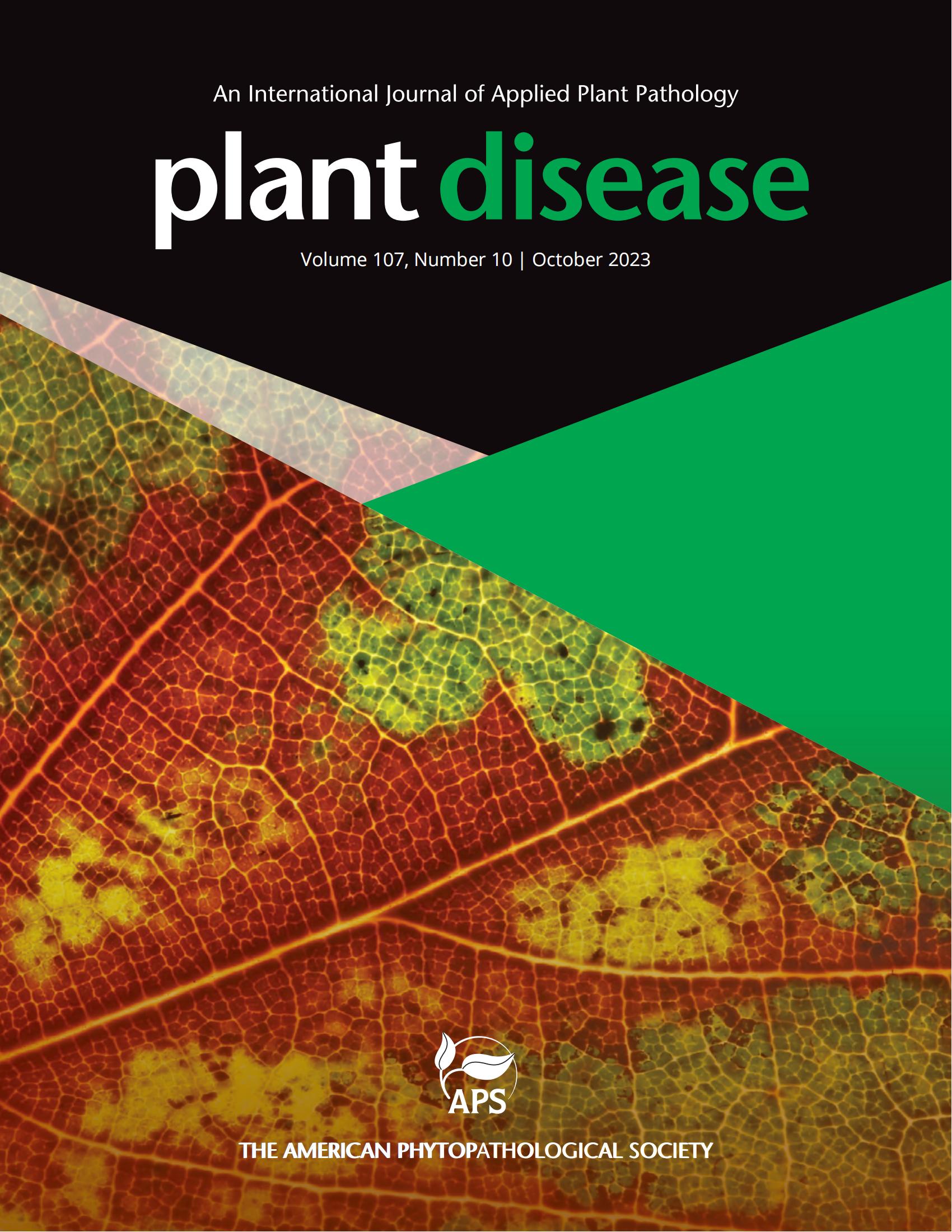中国江苏白术上由交替丝核菌(Alternaria alternata)引起的一种新的叶斑病。
摘要
白术是一种重要的中药材,主产于中国江苏省。2022 年 6 月,江苏南京植物园中药材资源圃的部分白术幼苗出现叶斑病症状。在 100 株长春花幼苗中,约 75% 的幼苗发病。最初,叶片顶端出现灰黑色病斑,然后向叶柄深处扩展,最后导致叶片枯萎和倒伏。为了分离病原体,从五株不同的秧苗上采集了五片病叶。从健康组织和病变组织之间的边缘切除叶片(3 至 4 毫米),在 75% 的酒精中进行表面消毒 30 秒,然后在 1.5% 的 NaClO 中消毒 90 秒,再用消毒蒸馏水冲洗三次,然后将其置于马铃薯葡萄糖琼脂(PDA)上,在 25℃的黑暗环境中培养。通过单孢分离获得纯培养物。其中具有代表性的分离物 CS4-1 被用于进一步研究。CS4-1 生长在 PDA 上的菌落呈棉花状,黑色至棕色,表面有灰白色气生菌丝,背面呈深灰色。分生孢子单生在分生孢子梗上,呈椭圆形至梨形,褐色,有 1 至 4 个横隔膜和 0 至 1 个斜隔膜,顶细胞伸入喙内,大小为 8.9 至 39.5×6.0 至 13.5 µm(n=35)。这些特征与 Alternaria spp.的描述一致(Simmons,2007 年)。六个 DNA 区域,即内转录间隔区(ITS)、大亚基核糖体 RNA(LSU)、小亚基核糖体 RNA(SSU)、匿名区 OPA10-2、Alt a 1 主要过敏原(Alta1)、3-磷酸甘油醛脱氢酶(GAPDH)和翻译延伸因子 1-α(TEF1),其 GenBank Accession No.OP836052、OP836054、OP836051、OP851487、OP851488、OP851489 和 OP851490,用 White 等人(1990 年)和 Woudenberg 等人(2015 年)描述的引物对进行扩增和测序。在 MEGA7 中结合所有测序位点生成了邻接系统发生树,CS4-1 聚类在交替蓟马支系中。为了测试致病性,用无菌针刺伤三株一个月大的 A. lancea 幼苗(每株幼苗四片叶子)的 12 片叶子,然后在叶子左侧接种 20 μL 分生孢子悬浮液(1×106 个孢子/毫升)。叶片右侧接种 20 µL 无菌水作为对照。所有接种的离体叶片和幼苗都用透明聚乙烯袋覆盖以保持湿度,并在 25℃、相对湿度 80% 和 12 小时光照/黑暗循环的温室中培养。实验重复三次。4 天后,所有接种叶片和接种秧苗的左侧都出现了典型的灰黑色斑点,右侧仍无症状。随后,根据形态和分子特征重新分离并鉴定了同一种真菌。交替花叶病毒的寄主范围很广,但在全球范围内从未有关于 A. lancea 的报道(nt.ars-grin.gov)。由于 A. lancea 具有药用价值,因此应进一步研究如何控制这种疾病。Atractylodes lancea is an important Chinese herbal medicine, which is mainly produced in Jiangsu province, China. In June 2022, leaf spots symptom were observed on some A. lancea seedlings growing in a Chinese herbal medicine resource garden of Nanjing Botanical Garden, Jiangsu. Approximately 75% of 100 A. lancea seedlings suffered from the disease. Initially, gray to black spots appeared at the tip of the blade, then spread deep into the petiole, finally causing the blade to wither and fall. To isolate the pathogen, five diseased leaves were collected from five different seedlings. Leaf sections (3 to 4 mm) were excised from the margins between healthy and diseased tissues, surface sterilized in 75% alcohol for 30 s, then in 1.5% NaClO for 90 s, rinsed three times in sterilized distilled water, plated on potato dextrose agar (PDA) and incubated at 25℃in darkness. Pure cultures were obtained by monosporic isolation. Eighteen isolates were obtained, and 77.8% of isolates was identified as Alternaria spp. A representative isolate, CS4-1 was used for further investigation. The colony of CS4-1, growing on PDA was cotton-like and black to brown with gray-white aerial hyphae on their surfaces, and dark gray on the back. The conidia were solitary on conidiophores and were oval to pear-shaped, brown in color, with 1 to 4 transverse septa and 0 to 1 oblique septa, parietal cells extending into the beak, and measured 8.9 to 39.5×6.0 to 13.5 µm (n=35). These characteristics were consistent with the description of Alternaria spp. (Simmons 2007). Six DNA regions, i.e.,internal transcribed spacer (ITS), large subunit ribosomal RNA (LSU), small subunit ribosomal RNA (SSU), anonymous region OPA10-2, Alt a 1 major allergen (Alta1), glyceraldehyde 3-phosphate dehydrogenase (GAPDH) and translation elongation factor 1-alpha (TEF1) with the respective GenBank Accession No. OP836052, OP836054, OP836051, OP851487, OP851488, OP851489, and OP851490, were amplified and sequenced with the primer pairs described by White et al. (1990) and Woudenberg et al. (2015). A neighbor-joining phylogenetic tree was generated by combining all sequenced loci in MEGA7, and CS4-1 clustered in the A. alternata clade. To test pathogenicity, 12 leaves, on three one-month-old A. lancea seedlings (four leaves from each seedling) were wounded with a sterile needle and inoculated with 20 μL of conidial suspension (1×106 spores/mL) on the left sides of leaves. The right sides of the leaves were inoculated with 20 µL sterile water and used as the control. All inoculated detached leaves and seedlings were covered with clear polyethylene bags to keep moisture and were incubated in a greenhouse at 25℃, 80% relative humidity, and a 12-h light/dark cycle. The experiment was repeated three times. After 4 days, typical gray to black spots were visible on the left sides of all inoculated leaves and the inoculated seedlings, and the right sides remained asymptomatic. Subsequently, the same fungus was reisolated and identified based on morphological and molecular traits. A. alternata has a very wide host range but has never been reported on A. lancea worldwide (nt.ars-grin.gov). Because of the medicinal value of A. lancea, further studies should be directed toward control of this disease.

 求助内容:
求助内容: 应助结果提醒方式:
应助结果提醒方式:


